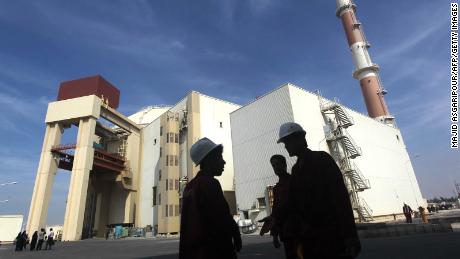Iran shoots down US drone aircraft, raising tensions further in Strait of Hormuz
Tehran, Iran (CNN)Iranian shot down a United States military drone on Thursday, further escalating the already volatile situation playing out between Washington and Tehran in the Middle East.
Iran's Revolutionary Guard said it had shot down an "intruding American spy drone" after it entered into the country's territory Thursday.
A US official confirmed to CNN a drone had been shot down, but said the incident occurred in international airspace over the Strait of Hormuz, one of the world's most vital shipping routes.
US Central Command, which oversees military operations in the Middle East, said in a statement Thursday that the drone that was shot down by Iran was a RQ-4A Global Hawk High-Altitude, Long, Endurance (HALE) Unmanned Aircraft System (UAS).
The head of the Revolutionary Guard Corps, Maj. Gen. Hossein Salami, said the shooting down of the drone had sent a warning to the US.
"The only way for our enemies to be safe is to respect our sovereignty, national security, and the national interests of the great Iranian nation," Salami said, according Tasnim.
In comments likely to inflame tensions, Salami said that Iran does "not want war with any country, but we are completely, and totally, ready and prepared for war."
In a statement issued on Thursday, the Revolutionary Guard said the drone was launched from a US base south of the Persian Gulf shortly after midnight on Thursday. It said it flew from the Strait of Hormuz towards Chabahar, a city in southeast Iran.
"While returning to the western Hormuz Strait's region the drone violated Iran's airspace and engaged in information gathering and spying," the statement said.
"At 4.05 a.m. local time while the violating airplane was over Iranian territory, [it] was shot down," it added.
According to Iran's semi-official Tasnim News Agency, the drone was shot down by Khordad-3 medium range air defense missile.
Iran's foreign ministry spokesperson Syed Abbas Mousavi said the country condemned the "aggressive and provocative action."
"We warn against any violation of Iran's airspace by foreign flying objects and declare that violators are responsible for the consequences of their actions," he was quoted by Tasnim as saying.
Reuters quoted Cap. Bill Urban, a spokesman for the US Central Command, as saying "no US aircraft were operating in Iranian airspace" Thursday.
Relations between the two adversaries have taken a dangerous turn this week, beginning with the Trump administration's decision Monday to deploy 1,000 additional troops and more military resources to the Middle East. The forces are being sent in response to what Washington called "hostile behavior by Iranian forces that threaten United States personnel and interests across the region."
US officials blame Iran for conducting attacks against oil tankers in the Gulf of Oman, and the US President himself last week accused Iran of being behind the provocation, telling Fox News: "It was them that did it."
Tehran has categorically denied the accusations, and President Hassan Rouhani said the country does not seek war but "is determined to show its hopefulness and vitality and defeat the enemy's plot."
The White House was holding a meeting Thursday to discuss a response to the escalation, a person familiar with the plans told CNN. President Donald Trump was not expected to attend.
A U.S. official tells Barbara Starr that outgoing Acting Defense Secretary Patrick Shanahan and incoming Acting Defense Secretary Mark Esper are both expected to attend at this point.
Iran has previously been accused of targeting US drones.
In the hours before the attack on the two tankers earlier this month, the Iranians spotted a US drone flying overhead and launched a surface-to-air missile at the unmanned aircraft, a US official told CNN.
In 2014, the Iran's armed forces revealed what it claimed was a copy of a stealth American drone "commandeered" by Tehran in 2011.
Relations between Iran and the United States have deteriorated since May 2018, when Washington chose to leave the 2015 nuclear deal the Iranian regime negotiated with world powers and reimpose crippling sanctions on Iran's economy.
Trump and many conservatives in the US had long criticized the deal, which allowed Iran to stockpile limited amounts of enriched uranium and heavy water produced in that process, exporting any excess.
Doing so has become extremely difficult after the US revoked waivers that allowed Iran to export those excess stockpiles, effectively forcing Iran to halt enrichment or ignore the limits, which it is now doing.
After a year of waiting, Rouhani announced last month that it would reduce its "commitments to the deal," but not fully withdraw from it.
Iran then announced this week that it would resume nuclear enrichment activities, accelerating uranium enrichment to 3.7% -- above the 3.67% mandated by the nuclear deal. Enrichment at this level is enough to continue powering parts of the country's energy needs, but not enough to construct a nuclear bomb.
Thursday's drone incident came after Saudi Arabia said that a projectile launched by Iranian-backed Houthi rebels in Yemen landed near a desalination plant in Al-Shuqaiq overnight. Trump has been briefed on the reports, according to the White House.
Adel al-Jubeir, the Saudi Minister of State for Foreign Affairs, told CNN's Christiane Amanpour on Thursday that Riyadh has made it "very clear that Iran's aggressive behavior must stop."
"We have it made it very clear that nobody wants war. We don't want war. The US doesn't want war," Jubeir said.
UPDATE: A US official previously identified to CNN the model of the drone as a MQ-4C Triton, but US Central Command later said it was an RQ-4A Global Hawk.




0 Commentaires